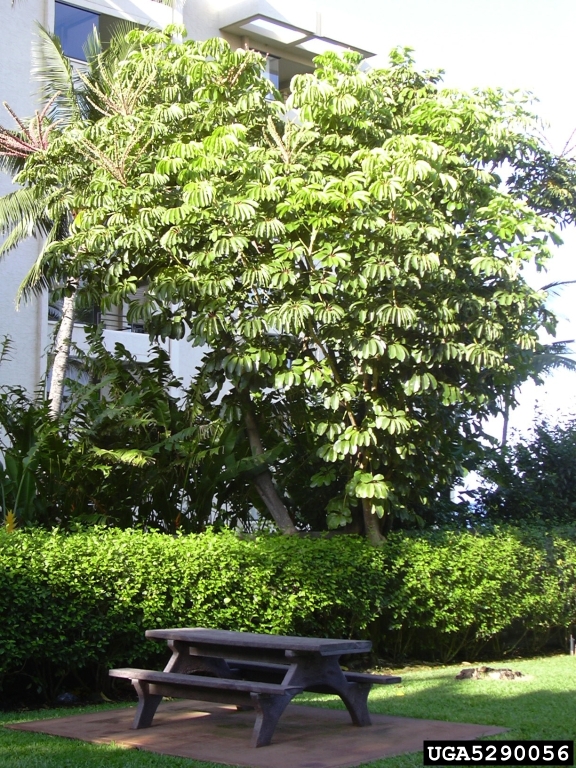Schefflera actinophylla
Octopus tree
Synonym(s): Brassaia actinophylla
Family: Araliaceae
Duration and Habit: Hardwood tree

Photographer: Forest & Kim Starr, Starr Environmental
Source: bugwood.org
Description
Octopus tree (Schefflera actinophylla) is a member of the family Araliaceae and has other common names (umbrella tree and ivy palm). Mature plants reach an average height of 40 feet and are either single or multistemmed. The broad green leaves are ovate, palm-like, and 12 inches long. Leaves are made up of 7-16 leaflets arranged in a circular pattern similar to a palm tree or umbrella. Red flowers develop on the ends of stems in late summer to early fall. The flowers are 1 inch wide and bear round, dark purple fruit, that is 1/4 inch in diameter.
Ecological Threat: The octopus tree is very difficult to control after it has become established in natural areas. It can be found invading areas native to scrub trees that suffer from a lack of sunlight caused by the large octopus tree shading native vegetation. One of the plants negatively effected by shading from the octopus tree is the endangered scrub pinweed (Lechua cernua), a native to Florida.
Biology & Spread: Flowering occurs in late summer to early fall, with seeds produced prolifically and dispersed by birds feeding on the fruit of the octopus tree. Fruit develops within 6 weeks of the flower developing, and can occur twice a year. The first inflorescence occurs in early summer, with an additional occurrence in early fall. Seed production has only been observed in plants that receive full sun, and are 10-15 years old. Reproduction does not occur vegetatively, but observations of regeneration have been made when branches or leaves are damaged.
History: The octopus tree was introduced to Florida in 1927 as an ornamental plant from Australia. By the 1970's the octopus tree escaped cultivation, and was found established outside of gardens in natural areas. It was also introduced to Hawaii as an ornamental tree ideal for resorts. It wasn't documented in natural areas until 2000, but by this time, it was a common occurrence across the islands.
U.S. Habitat: The octopus tree is able to tolerate a large variety of moisture levels, but are restricted to areas with warm climates and temperatures that remain above 35o F. It can be found in a variety of habitats such as sand dunes, beaches, forests, and cypress strands. In Hawaii the octopus tree is found in mesic disturbed habitats.
Distribution
Native Origin: Australia
U.S. Present: FL, HI
Management
The octopus tree is reported as very difficult to control because of the mechanism employed for seed dispersal by native bird species. For this reason, young or new infestations of octopus tree are easier to eradicate because seeds are not produced until 10 or more years of age. It is very important to monitor for establishment of the octopus tree in new areas to prevent further spread of the invasive plant. With little management options available, prevention and early detection are the most effective means in containing invasion of the octopus tree. Prescribed burning has been successful in managing octopus tree infestations in some cases, but minimal evidence is available to support this method. Herbicide control of the octopus tree is not an effective management method with effects seen months after the initial application.
Text References
Asher, Jerry, Steven Dewey, Jim Olivarez, and Curt Johnson. 1998. Minimizing weed spread following wildland fires. In: Christianson, Kathy, ed. Proceedings, Western Society of Weed Science; 1998 March 10-12; Waikoloa, HI. 51:49.
Menninger, Edwin A. 1971. Queensland umbrella tree, Brassaia actinophylla. American Horticultural Magazine 50(3): 141-142.
Thayer, Dan. 1998. Schefflera on the loose in south Florida. Wildland Weeds 1(2): 6-7.
Internet Sources
 Texas Invasive Species Institute
Texas Invasive Species Institute